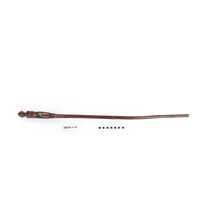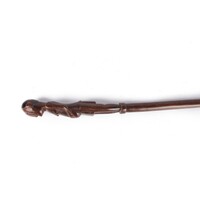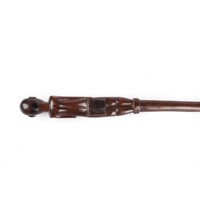Metadata
Figurative staff
[ Source of title : Nessa Leibhammer using JAG materials ]
Object
2012-6-70
Creative Commons License: CC BY-NC-ND
https://creativecommons.org/licenses/by-nc-nd/4.0/
Description
[Source - Maritz, N.G. Relics of War: A Collection of 19th Century Artefacts from British South Africa and Southern Rhodesia. Pretoria: Salut Africa CC, 2008, used without alteration by JAG, 2015: JAG Description: Figurative staff, North Nguni, 19th Century; Material: Wood]
Acquisition
[Source - Nessa Leibhammer for FHYA, 2015: Acquired from: Maritz bought this item from Kevin Conru an American dealer of African and Oceanic art based in the UK and in Brussels. Conru was previously the head of the African and Oceanic Departments of Bonham's auction house. Now a private dealer, he has assembled an important collection of early Southern African art. See Conru, K., Klopper, S and Nel, K. 2002. The Art of Southeast Africa from the Conru Collection. (Information provided by Karel Nel, 12 October 2014).]
Additional Title Information
[Source - Nessa Leibhammer for FHYA in 2015: Item named 'Fig Type 9' by Nessa Leibhammer.]
Attributions and conjectures
[Source - Nessa Leibhammer for FHYA, 2015: Object notes: Sandra Klopper discusses whether these figurative staffs should be classified as 'Tsonga' or 'North Nguni' by (Klopper 1989). See also Brenthurst catalogue entries e.g. JL-C-18 which is classified as Tsonga/North Nguni - 'produced for the tourist trade.']
Attributions and conjectures
[Source - Nessa Leibhammer for FHYA, 2017: Comments on classification: In his 'A Preliminary Survey of the Bantu Tribes of South Africa', Union of South Africa, Department of Native Affairs, Ethnological Publications, Vol. 5, Pretoria, Government Printer, (1935): 7, 70-83, national government ethnologist, Nicholas Van Warmelo did not use the term "North Nguni". He grouped people living both north and south of the Thukela, under one umbrella term, "Natal Nguni", based on linguistic affinity. His classification was adapted by the ethnology curator, Margaret Shaw, in her 1958 "System of Cataloguing Ethnographic Material in Museums" which determined that items from the region were to be classified as "Natal Nguni: Zulu and others (not differentiated)."
According to art historian, Anitra Nettleton, the classificatory system used by art galleries and museum shifted from Shaw's model to the one where "Natal Nguni" fell away and was replaced by "North/Northern Nguni" for KwaZulu-Natal and Swaziland because scholars found it difficult to distinguish items from adjacent areas, or emigrant people from those from the KZN region. Scholars working with the JAG materials used broad ethno-linguistic categories (Zulu, Xhosa, Tsonga, Shona, Sotho, Tswana) to identify the makers/users of the objects, all of which came to JAG without much by way of provenance, and identification was based on factors such as object type, materials, formal composition, style and surface patterning (emails A. Nettleton to N. Leibhammer, 25 and 28 November 2014).]
| Event Actor | Event Type | Event Date | Event Description |
|---|---|---|---|
| Five Hundred Year Archive (FHYA) | Online curation | 2016 - | Digital image by Nessa Leibhammer |
| Johannesburg Art Gallery (JAG) | Custody | 2012 - | |
| Nicholas Maritz | Collection | [19-?] | |
| Unacknowledged | Making | YYYY |
If you have difficulty accessing the objects, use these links.
Figurative staff
Figurative staff (view 2)
Figurative staff (view 3)
Figure staff (view 4)




Contributions